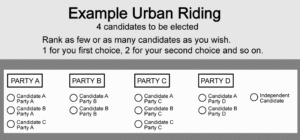Single Transferable Vote (PR-STV)
Single Transferable Vote was recommended by the British Columbia Citizens Assembly (2004) and went on to receive 58% of the vote in the 2005 referendum. The top three values of the BC Citizens Assembly were proportional representation, local representation, and voter choice. You can check out the work of the BC Citizens Assembly here.
STV is used nationally in Ireland, in four Australian territories, in Scotland for local elections and was used provincially in Winnipeg, Calgary and Edmonton for 30 years. It is the original proportional representation system.
STV is not one of the systems on the ballot in the BC referendum but it is a key component of one of the system voters can choose – Rural-Urban Proportional. With Rural-Urban Proportional, STV would be used to elect the MLAs in urban and semi-urban ridings.
How it Works
 Instead of electing one MLA in each single member riding (first-past-the-post), voters elect a small team of MLAs in a multi-member local district.
Instead of electing one MLA in each single member riding (first-past-the-post), voters elect a small team of MLAs in a multi-member local district.
For example, a five single member riding could become one multi-member district electing five MLAs. The five MLAs would reflect the diversity of how people voted.
The BC Citizens Assembly recommended districts elect between two and seven members, depending on the geography of the area.
STV is a candidate-centered system which allows voters to rank candidates based on what characteristics are most important to them. STV is the system that gives voters the most nuanced say over who fills the seats. It produces proportional results in the legislature and also offers popular independents a chance to be elected.
Voting is simple. Rank candidates as few or as many candidates as you want in any order you like. You can rank across party lines.
Counting the ballots is more complex than first-past-the-post, because voters preferences are taken into account to ensure that the team of MLAs elected to represent the local area reflects the preferences voters marked on their ballots.
There are many excellent videos on STV counting on our youtube channel in the systems playlist. To get the basic idea of how the ballots are counted, we recommend this video:
Two other good videos on STV can be found below.
Background
In 2015, three parties - the Liberals, the NDP and the Greens, representing 63% of voters - promised that if elected, 2015 would be the last election under first-past-the-post.
The NDP and Greens promised to implement proportional representation. The Liberals promised to end first-past-the-post, listen to expert advice and follow evidence-based policy on electoral reform, and to "make every vote count."